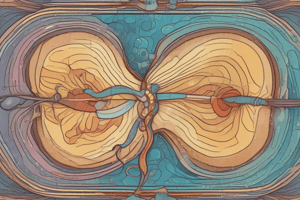Podcast
Questions and Answers
What is a common symptom of Benign Prostatic Hyperplasia (BPH)?
What is a common symptom of Benign Prostatic Hyperplasia (BPH)?
- Frequent urination (correct)
- Painful urination
- Difficulty starting urination
- Blood in the urine
What diagnostic test is used to measure urine flow?
What diagnostic test is used to measure urine flow?
- Cystoscopy
- Prostate-specific antigen (PSA) test
- Digital rectal exam (DRE)
- Urine flow study (correct)
What type of medication is used to slow prostate growth and reduce symptoms?
What type of medication is used to slow prostate growth and reduce symptoms?
- Phosphodiesterase inhibitors
- 5-alpha-reductase inhibitors (correct)
- Alpha-blockers
- Antibiotics
What is the goal of bladder training in managing BPH?
What is the goal of bladder training in managing BPH?
What is the purpose of Kegel exercises in managing BPH?
What is the purpose of Kegel exercises in managing BPH?
What is the name of the surgical procedure that removes part of the prostate?
What is the name of the surgical procedure that removes part of the prostate?
What is watchful waiting in the context of BPH?
What is watchful waiting in the context of BPH?
What is the purpose of alpha-blockers in managing BPH?
What is the purpose of alpha-blockers in managing BPH?
What is the name of the diagnostic test that examines the prostate gland through the rectum?
What is the name of the diagnostic test that examines the prostate gland through the rectum?
What is the purpose of lifestyle adjustments in managing BPH?
What is the purpose of lifestyle adjustments in managing BPH?
Flashcards are hidden until you start studying
Study Notes
Benign Prostatic Hyperplasia (BPH)
Symptoms and Diagnosis
- Common symptoms:
- Frequent urination
- Urgency to urinate
- Weak stream
- Straining to urinate
- Nocturia (frequent nighttime urination)
- Diagnostic tests:
- Digital rectal exam (DRE)
- Prostate-specific antigen (PSA) test
- Urine flow study
- Cystoscopy
- Ultrasound
- Urodynamic tests (e.g., uroflowmetry, cystometry)
Treatment Options
- Watchful waiting: Monitoring symptoms and adjusting lifestyle habits
- Medications: Alpha-blockers, 5-alpha-reductase inhibitors, phosphodiesterase inhibitors
- Minimally invasive treatments:
- Transurethral resection of the prostate (TURP)
- Transurethral incision of the prostate (TUIP)
- Laser therapy
- Microwave therapy
- Surgery: Open prostatectomy, laparoscopic prostatectomy
Medication Management
- Alpha-blockers: Relaxes prostate and bladder neck muscles, improving urine flow
- Examples: doxazosin, terazosin, alfuzosin
- 5-alpha-reductase inhibitors: Slows prostate growth, reducing symptoms
- Examples: finasteride, dutasteride
- Phosphodiesterase inhibitors: Combines with alpha-blockers to improve symptoms
- Examples: tadalafil
Lifestyle Changes
- Dietary modifications:
- Increase fluid intake to prevent dehydration
- Avoid caffeine and alcohol, which can irritate the bladder
- Bladder training:
- Delay urination to strengthen bladder muscles
- Gradually increase time between trips to the bathroom
- Kegel exercises: Strengthen pelvic floor muscles to improve bladder control
- Lifestyle adjustments:
- Avoid activities that exacerbate symptoms (e.g., heavy lifting)
- Manage stress to reduce symptoms
Studying That Suits You
Use AI to generate personalized quizzes and flashcards to suit your learning preferences.




